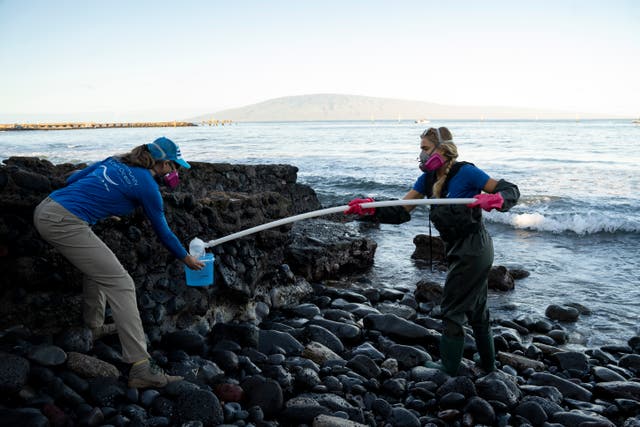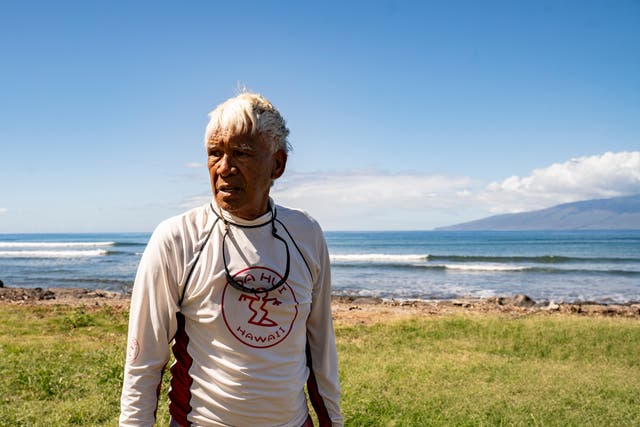
Ian Payne 4am - 7am
3 March 2024, 08:24

The blaze in Lahaina last August killed at least 100 people and scorched more than 2,000 buildings.
Residents of the Hawaiian island of Maui have voiced concern about potential damage to marine life following the deadliest US wildfire in a century.
The blaze in Lahaina last August scorched more than 2,000 buildings and left behind piles of toxic debris, and there are fears run-off could carry contaminants into the ocean and affect the coral, seaweed and the food chain.
Lifelong resident Abraham Ah Hee spends so much time in the ocean that his wife jokes he needs to wet his gills. “Now with all these things happening, you don’t know if the fish is good to eat,” he cautioned.
Scientists say there has never been another instance of a large urban fire burning next to a coral reef anywhere in the world and they are using the Maui wildfire as a chance to study how chemicals and metals from burned plastics, lead paint and lithium-ion batteries might affect delicate reef ecosystems.

The research, which is already under way in the waters off Maui, could ultimately help inform residents, tourists and coastal tropical communities worldwide as climate change increases the likelihood of extreme weather events of the kind that fuelled the wildfire.
A Bill before the state House would provide long-term funding for water quality monitoring in the hope of providing answers for residents whose lives are closely tied to the ocean.
For now, state officials are urging the public to limit their exposure to the ocean and seafood until scientists understand what might be making its way through the food chain.
Russell Sparks, Maui aquatic biologist at the state Department of Land and Natural Resources, said: “I know a lot of people keep asking, ‘Is the water safe? Can we go out? Is it safe to fish and eat the fish?’.
“We just want to reinforce the message that we know it’s frustrating, but if people can be patient. We’ve never encountered anything like this.”
Coral reefs are sometimes called the “rainforests of the sea” because they are so crucial for healthy oceans. They are made up of stony corals, which are hard skeletons formed by thousands of individual living coral polyps that symbiotically host algae. Fish, crabs and other species find refuge in their midst.

Scientists say one fourth the ocean’s fish depend on healthy coral reefs, which also protect shoreline communities from powerful waves during storms.
One of Hawaii’s oldest stories, the centuries-old chant called The Kumulipo, reflects the central role of coral in the island chain. It says a coral polyp was the first living being to emerge from the darkness of creation. Starfish, worms, sea cucumber and other species followed. Humans came last.
Ekolu Lindsey, a Lahaina community advocate who has long pushed to restore coral reefs, fishing and traditions in his hometown, said: “So the first form of life is a coral polyp. That is your foundation. The foundation of life is a coral.”
Lahaina’s coral reefs had challenges even before the fire, including overfishing, abuse from kayak and stand-up paddleboard tours, warm ocean temperatures and sediment flows from fallow fields and construction sites, Mr Lindsey said.
Much of the coral offshore of the burn zone was already degraded prior to August, Mr Sparks said, but there were some patches of nice reef, like in an area north of Lahaina Harbour towards Mala Wharf.
University of Hawaii at Manoa researchers obtained a 200,000 US dollar (£158,000) grant from the National Science Foundation to test the water soon after the fire.
In October, they placed 20 sensors off West Maui that measure temperature, salinity, oxygen, turbidity and chlorophyll every five minutes. They have six sensors measuring where water is flowing for clues on where contaminants might travel and accumulate.

The Hui O Ka Wai Ola citizen science group collects additional samples, including after heavy rain events.
Researchers are taking tissue fragments from fish, seaweed and coral for signs of heavy metals and contaminants from burned wood, metal and plastics.
So far they do not have enough data to draw conclusions but they aim to release some results within a month.
Andrea Kealoha, a Manoa professor and Maui native who is leading the research project, said she suspects scientists may detect contaminants accumulating in plants and animals over the next two to five years. Degraded reefs and lower water quality could emerge over the same time frame and she is pressing for a long-term monitoring plan that could be supported with state funds.
The wildfire’s effects may also stretch beyond Maui, because scientists believe currents carry water from Lahaina to nearby Lanai and Molokai.
“Fish that you collect to eat off of a reef on Molokai may very well have compounds that washed into the water from rainfall in Lahaina and got transported to ocean currents across the channel and on to the reefs of neighbouring islands,” said Eric Conklin, the Nature Conservancy’s director of marine science for Hawaii and Palmyra.
Authorities have been trying to limit harmful run-off. Rubble and ash is being removed from the area, while a soil stabiliser is being applied to prevent ash and dust from dispersing. Protective barriers have been placed alongside storm drains and coastal roads to block debris.